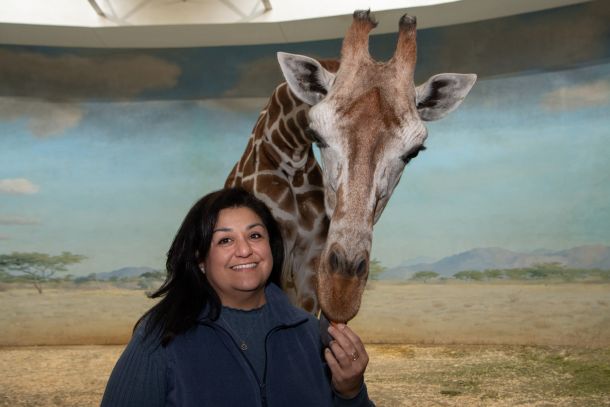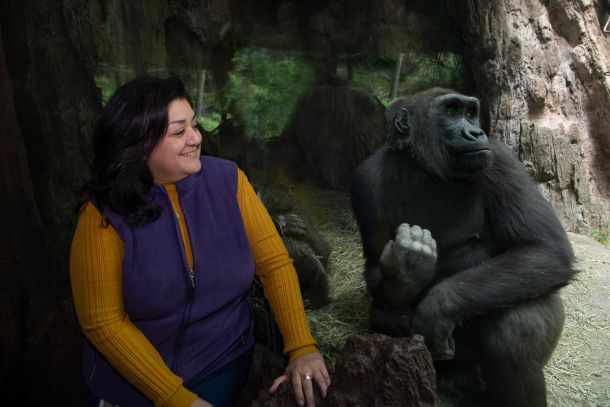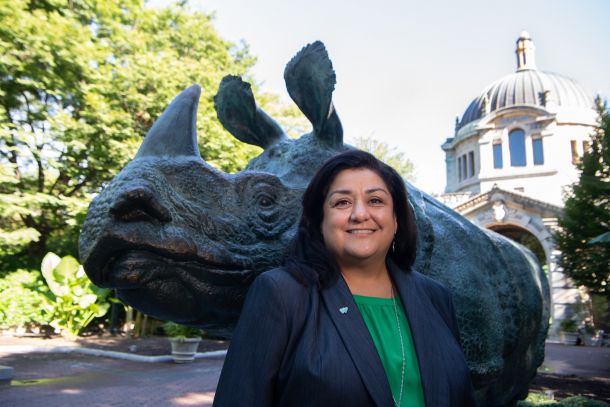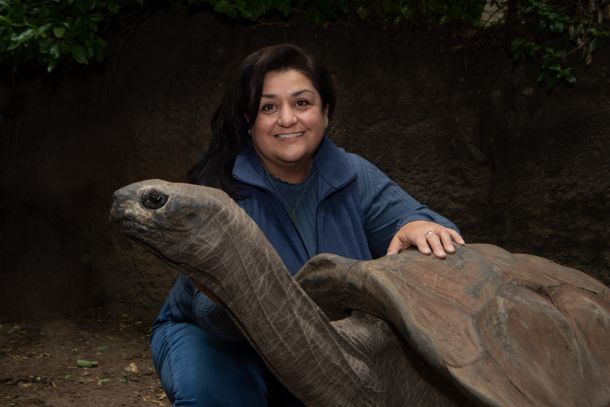This piece comes to us from the Wildlife Conservation Society (WCS). To honor Hispanic Heritage Month, WCS and Nature are bringing you stories in the fields of nature and conservation.

Spending time with Thabisa, a guest favorite at Carter Giraffe House, Bronx Zoo. Photo credit: Julie Larsen Maher © WCS.
Like many zoo and aquarium professionals, I’ve long had a deep appreciation for animals and nature. I suspect some of us are just born that way. But there are moments and experiences that strengthen our love of wildlife and the desire to protect it. For me, so many were made possible by my parents, who encouraged me to pursue interests that sparked wonder, awe, and joy.
As a kid growing up in Houston, this meant playing with my dog, spending vacations in nature, and visiting the zoo. A zoo visit was affordable for my family and that made it so much easier for my parents to say yes to me almost every time I asked—and I asked a lot! I was particularly drawn to the great apes, big cats, sea lions, alligators, and giant tortoises.

Building a core memory with wildlife, Sea Lion Exhibit, Houston Zoo. Photo courtesy of Lisa Marie Avendaño.
A Mexican-American native of South Texas, my dad worked as a pipefitter in the oil and gas industry. I recently asked him what motivated him to spend our vacation time outdoors, and he told me it was a necessary break from the classroom and the welding shop. “We just needed to get out, we needed to be in nature,” he explained.
While I loved wildlife and nature, it did not occur to me that they could be part of my career. After college, I came across the brochure for a community college veterinary health program describing its partnership with my local zoo—training students in veterinary and zookeeper technology. That was the moment. I started to believe that I belonged at a zoo and had something to contribute.
I committed myself to the course and volunteered at my hometown zoo. Before I even finished the program, I landed my first job as an apprentice zookeeper, taking care of a wide variety of species—first in the children’s zoo and then as a clinic keeper in the zoo hospital. The purpose and focus of this work were like nothing I had experienced. I was making a difference in the daily lives of animals, ensuring they had everything they needed to thrive. And I was working alongside like-minded people as committed to the zoo and wildlife as I was.

Releasing endangered green sea turtles as part of zoo-based rehabilitation programming on the upper Texas coast. Photo courtesy of Lisa Marie Avendaño.
Working in a variety of roles, I learned that we, as professionals working in accredited zoos and aquariums, can and should impact the well-being and the future of animal populations in the wild. I worked with endangered species and on any given day, I might be providing husbandry for Attwater’s prairie chickens, processing sea turtle blood in the laboratory, or ordering field conservation supplies for Houston toads.
To me, the purpose of a zoo and aquarium is to connect all people to wildlife by providing an opportunity to learn about threats different species face in their natural range, what zoos and aquariums are doing about those threats, and how visitors can help. For this model to work, we need everyone to feel welcome.

Getting eye level with the Western lowland gorilla, a priority species for the WCS Africa Program. Congo Gorilla Forest at the Bronx Zoo is a groundbreaking exhibit for animal well-being and guest experience, and to date has helped raise 20 million in funding to support the conservation of gorillas. Photo credit: Julie Larsen Maher © WCS.
I tend to believe that things work out in life the way they are supposed to and that every experience, achievement, or challenge is part of the journey. Would things have been easier for me as a teenager or young adult if I had encountered more Hispanic zoo and aquarium professionals?
I do not know the answer to that. I didn’t realize I could belong in this world until past my mid-20s, but once I found it, I crossed paths with a long list of true mentors, leaders, and friends that didn’t look like me or come from the same background, but who saw me, valued me, and went out of their way to include and support me. They opened a world of possibility and for that, I am so grateful.

The historic Zoo Center, Bronx Zoo, New York City. Photo credit: Julie Larsen Maher © WCS.
Still, I know that representation matters. It mattered to me when I saw the first woman serve as vice president of animal care at my hometown zoo. I gained confidence in myself and the belief that I could continue to serve with a greater range of responsibilities and in higher roles at my organization, and eventually, I did. I went on to complete a graduate degree and will soon complete an MBA.
I also know that representation matters because the young people of color who reach out to me tell me it matters. They find me at conferences, email me, and reach out on social media to describe their journeys in this profession and what it means to see me in a top leadership role influencing the direction and strategy of animal care and conservation at a revered institution. They feel that anything is possible for them, too.

“Connecting with an Aldabra tortoise at the Bronx Zoo turns me back into a kid,” says Lisa Marie. Visits with giant tortoise species were some of her best early zoo memories. Photo credit: Julie Larsen Maher © WCS.
Today, I am serving in a leadership role that allows me to continue the work of connecting people to animals while working in one of the most diverse cities in the U.S. and as a member of one of the most far-reaching conservation organizations in the world. Everyone is needed and everyone is welcome in the mission to save wildlife and wild places.
